Venice should rank highly as a top destination if you’re looking for an unforgettable experience on an Italian vacation. Known worldwide for its history and culture, beautiful architecture, famous bridges, tobacco shops, graffiti, festivals, and ubiquitous (if slightly smelly) canals.
If you’ve ever wondered when the best time to visit Venice might be, you’d better start planning soon. Climate change is increasing the high tides in the lagoon Venice wallows, causing flooding (acqua alta to the locals). Eventually, Venice may become the next Atlantis.
So, when is the best time to visit Venice? What time of year is Venice’s most famous local event? When are the large crowds thin, and when are there fewer tourists? When is acqua alta at its worst? When is peak season? The shoulder season? The off-season? The high season? The low season? The best weather? The bad weather? Steady yourself, dear reader; I am here to guide you.
Well, in short, the absolute best times to visit Venice for the vacation of your dreams are April through early June and September through October. During these months in northern Italy, you can expect mild temperatures that aren’t too hot and much smaller crowds than you’ll find during the summer.
Don’t visit Venice in August because locals of many big Italian cities (Venice included) take a month-long vacation, and there’s very little to do. If you’re up for a unique experience, consider visiting in the winter to avoid crowds and enjoy a romantic blanket-filled gondola ride through the city.
Weather in Venice
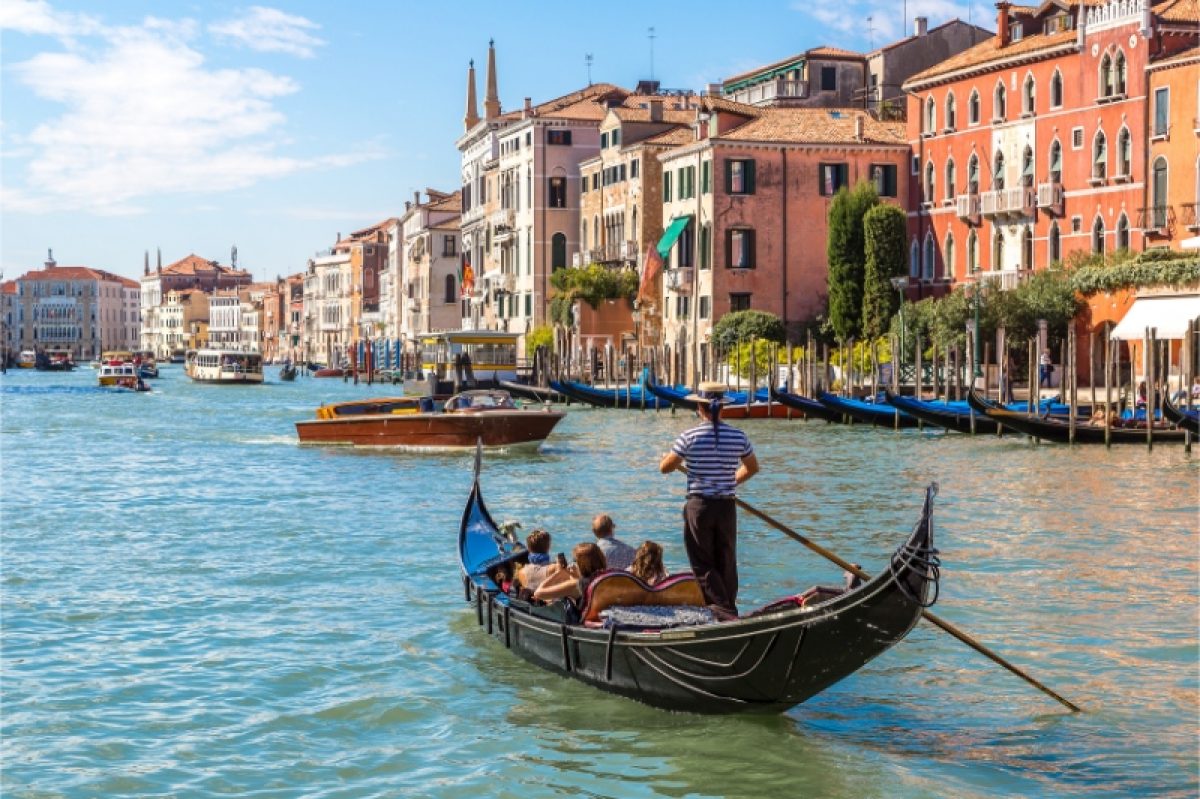
Located in northern Italy, Venice gets (and stays) a bit colder than some other major Italian cities such as Rome, Florence, and Milan. Even during the high summer tourist season, the average temperature is pretty temperate compared to most of Italy’s scorching inland cities, such as Bologna or Florence.
That said, the best times of the year to visit Venice for great weather include May, June, September, and October. These months typically offer daytime temperatures, averaging between 65°F and 78°F. The rainfall in Venice is all over the place, so it’s tough to plan around that. Although you can expect a few summer thunderstorms, the summer tends to stay drier.
Venice sees longer winters than most Italian cities, and it can get pretty cold, with average temperatures only getting up to around the mid-40s during the day. At night, temperatures drop below freezing, so bring warm clothes and maybe even some blankets if you’re thinking of a romantic winter gondola ride along the Grand Canal.
During the summer, Venice stays more comfortable than most other cities in Italy, with daytime high temperatures averaging the low to mid-80s. However, the high temperatures can still occasionally get up to 100°F or so, so we don’t recommend traveling here in July or August, especially considering the high humidity and increased smells. Based purely on the weather, you might consider late spring through early summer the best time to visit Venice.
See Related: Best Time to Visit Tuscany
Historical Weather in Venice by Month
| Month | Average High (°F) | Average Low (°F) | Average Precipitation (inches) |
|---|---|---|---|
| January | 46°F | 32°F | 2.4 inches |
| February | 49°F | 34°F | 2.2 inches |
| March | 56°F | 40°F | 2.6 inches |
| April | 63°F | 47°F | 2.8 inches |
| May | 71°F | 55°F | 3.0 inches |
| June | 78°F | 62°F | 2.9 inches |
| July | 82°F | 66°F | 2.4 inches |
| August | 82°F | 65°F | 3.2 inches |
| September | 75°F | 59°F | 3.5 inches |
| October | 66°F | 51°F | 3.9 inches |
| November | 54°F | 42°F | 3.9 inches |
| December | 47°F | 35°F | 2.8 inches |
Best Time for Staying Outdoors in Venice: May through June and September through October
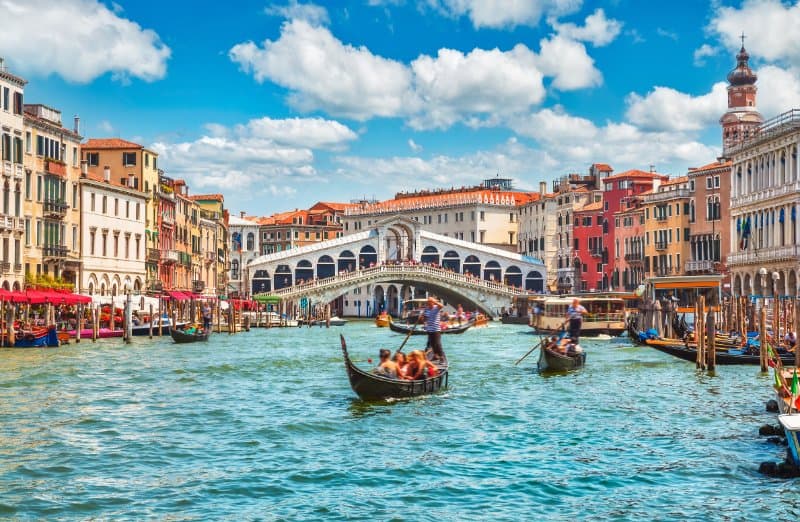
The best time to visit Venice and have the ability to spend most of your trip outdoors will be May through June and September through October. These months of the year provide the most pleasant weather in Venice. Not too hot, not too cold. Plus, if you’re here in September, you’re in time for the Venice Film Festival!
A trip to Venice in the winter will be met with the coldest temperatures of the year, with the average going down to around freezing (32°F) overnight, with the lows getting even colder at times. But traveling during the summer will sometimes leave you outside with some unbearable heat, often shooting up to over 100°F during the day. You won’t want to be outside too much during winter or summer in Venice!
If you plan on staying outdoors all the time, the best time to visit Venice is from May through October. This is because the average low temperatures in Venice during this time will typically range from 50°F to 65°F. Anything cooler than that, and you won’t want to stay outdoors overnight.
See Related: Best Time to Visit Sicily, Italy
Best Time for Sightseeing & Museum Hopping: April through June, September through October
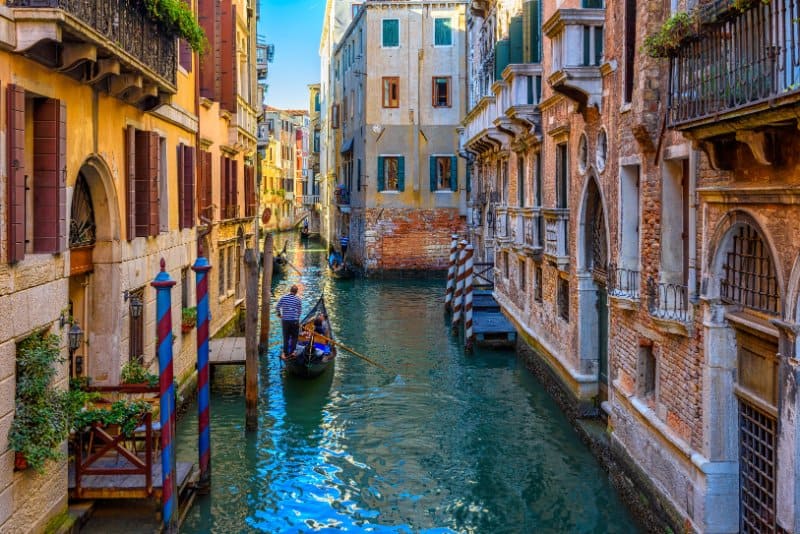
The best times for sightseeing and museum hopping in Venice are late April through June and September through October. As most of the sightseeing you’ll want to do in Venice is outdoors, you want to ensure that you have good weather, which is exactly what these times of the year will provide.
The temperatures in Venice tend to range between 60°F through 80°F during these times of the year, providing some of the most comfortable temperatures you’ll experience. Although early spring and late fall have a higher chance of rainfall, that’s the perfect time to visit museums rather than walk around outside.
If you plan your Venetian sightseeing trip in the middle of summer, you’ll have to walk outside while getting beaten down by the hot summer sun. And with as hot as it can get in Venice (upwards of 105°F at times), you won’t want to be spending much time outside at a time.
As a bonus, traveling during this time will also avoid the busy streets and crowds that the summer months draw in, so it’s the perfect time for sightseeing!
See Related: Best Time to Visit Cinque Terre (& Italian Riviera)
Best Time for Honeymooners: May through June, September through early October
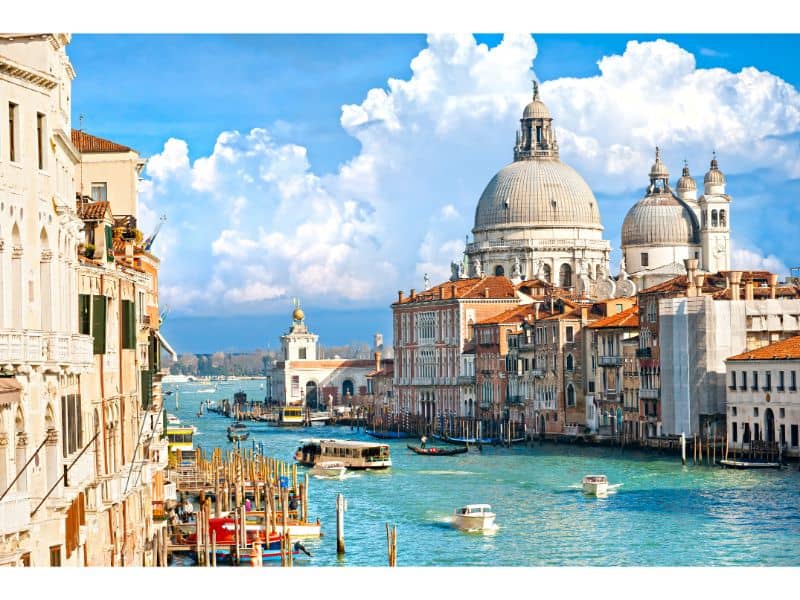
The best time to visit Venice for your dream honeymoon is May through June and September through early October. If you’re looking for a picture-perfect honeymoon, you want three things: pleasant temperatures, little chance of rain, and fewer crowds.
And that’s exactly what May, June, September, and October have to offer. Traveling during the summer months will provide the lowest chance of rain, but you’ll have to deal with the sweltering heat of the summer sun, which can be downright unbearable at times. You’ll also have the crowds of the high travel season to contend with.
Traveling during the winter has the coolest temperatures and fewest crowds. Still, even in Venice and the rest of Italy, the temperatures can get a bit too cold for the perfect honeymoon. Traveling earlier in the spring or later in the fall than we’ve suggested will get into the rainiest months of the year, potentially ruining any honeymoon if you’re trapped inside the whole time.
Read Also: Venice vs Florence: Which Iconic Italian City to Visit in 2025
Best Time for Budget Travelers: Winter months (December through late February/early March, except the holidays)
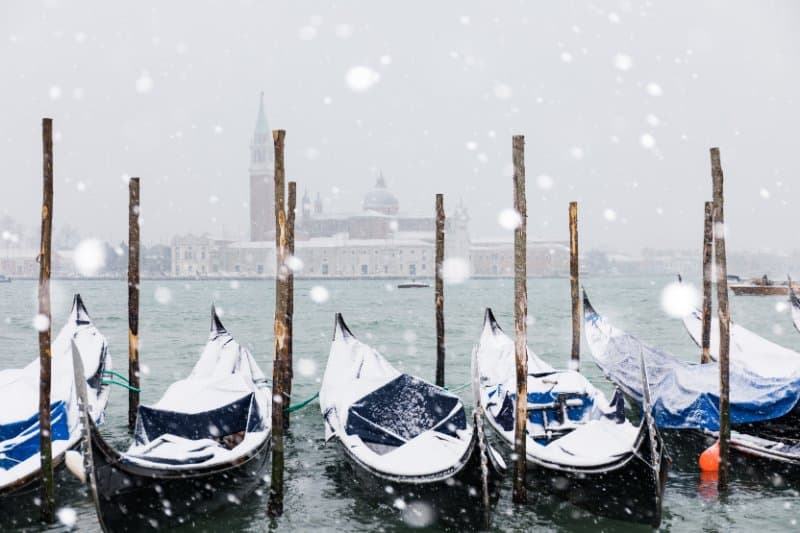
The best time to visit much of Italy, including Venice, if you’re on a budget is during the winter months of December, January, and February. As the low-travel season, thanks to the cold winters, this time of year is when hotels and other places have the best deals to entice travelers and customers to make the trip.
During the high summer travel season, hotels throughout Italy will hike prices because they know they’ll still get booked. Similar to the holidays, especially Christmas, the Epiphany, and Easter, places around the country will be more expensive to stay and visit.
With that in mind, watch out for booking your winter Venetian vacation during the two weeks that encapsulate Christmas, New Year’s, and the Epiphany (January 6th, a national holiday in Italy) as those budget-friendly prices you’re looking for will suddenly be much higher than you might think.
Most Venetian hotels tend to get booked 4-6 months in advance during the winter high season. So make sure you start looking early to get the best deals possible!
If you can stretch the budget a little, see if you can be in town for Carnevale. Held in late February or early March, this is arguably the most famous event of all key events in Venice, marked with fancy dress parties and the famous Venetian masks.
Remember, if you’re visiting in winter, be aware of the elements, including the aqua alta. Pack warm clothing and rain boots to handle the cooler, wetter weather.
See Related: Best Time to Visit Amalfi Coast, Italy
Best Time for Shopaholics: January through February and July through August
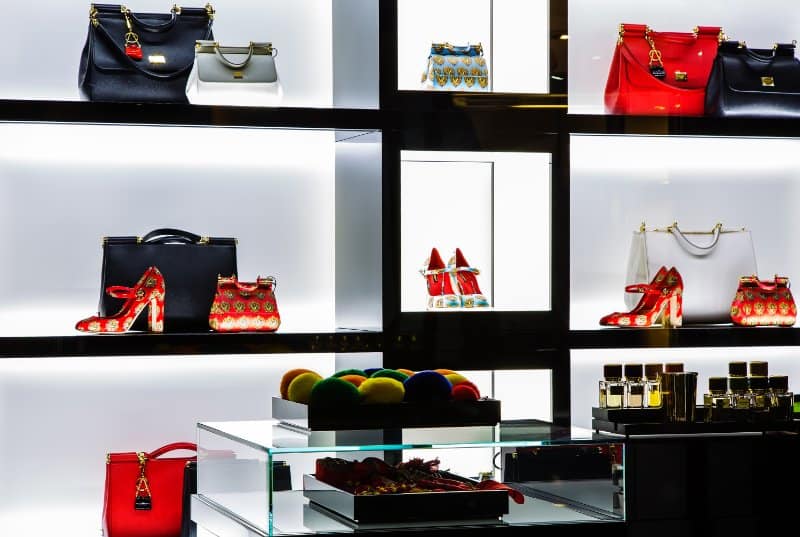
Italy is home to some of the most luxurious brands in the world and an overall incredible shopping experience. The best time of year to visit Venice for shopping is during the winter and late summer. This is because, throughout Italy, you’ll find winter and summer sales every year.
Starting around New Year’s Day (a public holiday in Italy), the winter sales begin and continue until the on-sale inventory runs out. Similarly, summer sales hit and continued for the same reasons as in July. Of course, not everything is on sale everywhere you go, but it’s common for most places to have sales of some sort.
Getting to Venice early during these seasonal sales can save anywhere from 25% to 50% off. But if you can time it right and get there later — but before the inventory runs out — you could save a staggering 70% or more.
Any shopaholics must visit Italy at least once to take it all in and see what the country offers. Venice is no exception. And with winter and summer deals like this, it’s a no-brainer when you should go.
If you are here for the winter sales, you should plan to be here for New Year’s Eve. The new year is rung in true Venetian style as thousands gather in Piazza San Marco (Saint Mark’s Square) for a giant group kiss, followed by a festive fireworks display!
If you decide to visit in July, I highly recommend you see if you can attend Festa del Redentore (the Feast of the Most Holy Redeemer). This famous event, held on the third Sunday of July, features fireworks and an amazing pontoon bridge of barges connecting the Zattere waterfront with the Chiesa del Redentore on the island of Giudecca.
The major downside of visiting during the peak season at the height of summer is that most European countries will be on summer holidays. This means tourist crowds are at their thickest, and hotel rates are at their highest. It’s also worth noting that from mid-August, many locals will go on their summer holidays, and many local businesses may shutter for a few days.
Read Also: Where to Stay in Venice: Top 4 Dreamy Accommodations for Every Budget
Best Time for Gondola Rides: January (Realistically, Year-Round)
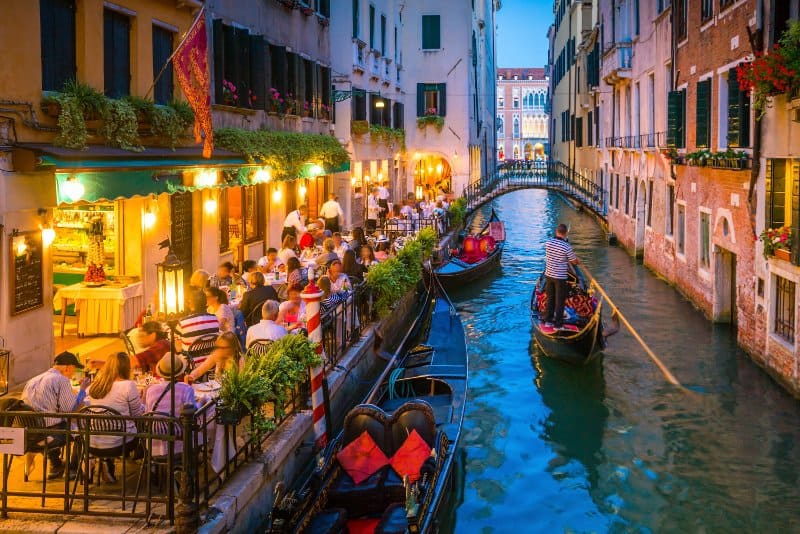
We know it might seem strange to recommend gondola rides in the winter. Remember that while chilly, Italy’s winters aren’t nearly as cold as other places in the world, and there are plenty of benefits to choosing winter for your gondola experience.
First and foremost, there are fewer crowds. Venice’s canals get packed with visitors and locals during the summer high-travel season. The city streets will be far busier and full of people, and the canals and waterways will have significantly more traffic.
Going in the winter avoids busy crowds while providing a unique gondola experience that most people never get to experience. The tour company will provide blankets for you to cuddle up next to that special someone, and you’ll have the opportunity to see Venice and the canals in a whole new light and see how they look in winter.
If you don’t want to go during the winter, we suggest early spring or late fall to still avoid some of the crowds. As a bonus tip, we recommend booking your gondola ride early in the morning or making it a lunch adventure. Most people go around during and during sunset, so any time of year that you’re visiting will avoid some of the bigger crowds.
FAQs
How many days do you need in Venice?
We recommend you book at least two full days in Venice to see and do most of the major attractions. But if you want to spend more time there, feel free to book a few more days—there’s plenty to see and do!
What is the rainiest month in Venice?
The wettest month in Venice is a dead heat between May and November, which surprises many people. Even though the city is famous for its waterways and canals, the wettest months in Venice still only average a few inches of rainfall.
When should I not visit Venice?
Don’t visit Venice in August. Not only is the weather incredibly hot and almost unbearable, but the locals also leave for a month-long vacation, and there’s significantly less to do in the city. You might also want to avoid visiting when acqua alta is at its worst.
When is the best time to avoid acqua alta?
Acqua alta can occur anytime between late September and April, and if we’re honest, it’s becoming more common throughout the year and harder to predict. One thing for certain is that it is most common in November and December.
Related Resources

0 Comment